The Perfect Table Size for Round Diamonds Explained
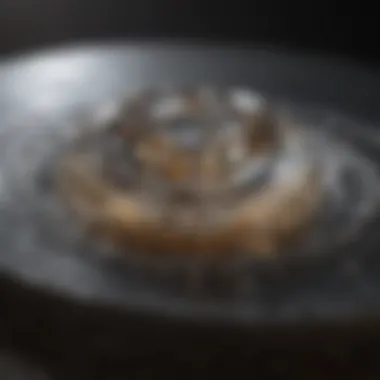
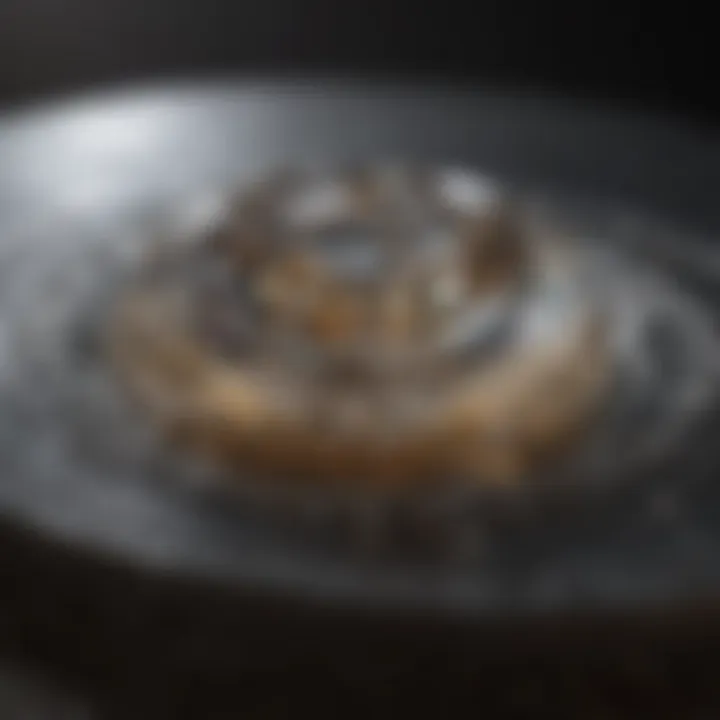
Intro
The significance of table size in round diamonds cannot be overstated. It plays a vital role in determining how a stone interacts with light, which in turn influences its brilliance and overall attractiveness. This article aims to elaborate on this pivotal aspect of diamond characteristics, diving deep into what constitutes the ideal table size, its effects on visual appeal, and its importance for both buyers and enthusiasts alike.
Gemstone Overview
Definition of Gemstones
Gemstones are naturally occurring minerals or rocks that possess beauty and rarity, often cut and polished for use in jewelry. They stand out not just for their physical properties but also for the emotional and cultural value they carry. Among the vast array of gemstones, diamonds hold a unique position due to their exceptional hardness and optical brilliance.
Classification of Gemstones
While gemstones can be broadly classified into precious and semi-precious categories, diamonds are often placed in a league of their own. The classification can further be delved into several specific types based on their chemical composition and origin. The different types include:
- Natural Diamonds: Formed over millions of years under high-pressure, high-temperature conditions.
- Synthetic Diamonds: Man-made stones created in laboratories, replicating the natural conditions that form diamonds.
- Fancy Color Diamonds: These stones come in various colors owing to the unique impurities within them.
Each type carries its own characteristics, but when it comes to round diamonds, the focus shifts to their cut, particularly the table size and its contribution to the gemstone's allure.
Historical Significance
Origins of Gemstone Use
The fascination with gemstones dates back thousands of years, tracing its roots to ancient civilizations where they were often regarded as symbols of wealth and status. Round diamonds, with their unparalleled sparkle, were reserved for only the most elite. Archeological findings suggest that the oldest diamonds known were discovered in India, where they were used to adorn weapons and later in jewelry.
Cultural Insights: Gemstones in Ancient Civilizations
In ancient cultures, gemstones were imbued with mystical qualities. For example, the Egyptians believed that certain stones could ward off evil or bring good fortune. Round diamonds specifically, owing to their brilliance and clarity, became symbols of eternal love, especially in wedding rings. This underlying sentiment has continued to make them a popular choice in modern times.
"Diamonds are not just stones; they are embodiments of emotions, commitments, and memories."
Understanding the context and underlying importance of diamonds enhances their perceived value for buyers and collectors alike. As we move forward, the exploration will narrow in on how the table size of a diamond directly impacts its performance and allure, shaping the perspectives of those who appreciate these magnificent gemstones.
The Importance of Table Size in Round Diamonds
Table size is a critical element when discussing round diamonds. It plays a pivotal role in a diamond's overall aesthetic and light performance. When it comes to evaluating diamonds, understanding the significance of table size can help both buyers and enthusiasts appreciate the nuances that differentiate one stone from another.
When one thinks about the table size, it isn't just a matter of measurements, but how that measurement influences the entire visual experience. The table size directly affects how light interacts with the diamond. This, in turn, can significantly influence both the perceived beauty and the value of the stone. It’s a balancing act where even small variations can have outsize effects on brilliance and fire.
Understanding Table Size
Table size refers to the flat surface on the top of a diamond. For round diamonds, it is typically expressed as a percentage of the overall diameter of the stone, providing a clear numeric representation of how much of the diamond’s surface is flat. This measurement helps to define the diamond's proportions. A well-balanced table size allows maximum light reflection and refraction, contributing to the stone's glow.
For instance, a table that is too expansive can dim light performance, while one that is too small might produce a stone that looks overly deep or bulky. In the hunt for the right diamond, grasping this concept allows one to appreciate not only the diamond’s visual attributes but also its craftsmanship.
Impact on Aesthetics
The aesthetics of a round diamond rely greatly on its table size. It can affect the diamond’s visual proportions, altering the viewer's perception of depth and size. A larger table can create an illusion of a bigger diamond but may compromise the overall symmetry and balance. In contrast, a smaller table size can enhance the depth perception and give a more refined look, yet it may also reduce the mass of light reflected back to the viewer.
- A larger table size might:
- A smaller table can:
- Enhance perceived size.
- Dull brilliance if incorrect.
- Create a delicate appearance.
- Intensify light effects if balanced nicely.
Role in Light Performance
Light performance hinges on how well a diamond can bounce and reflect light. The table size is essential in this process as it dictates how light enters the diamond and what happens next. A table that is well-proportioned allows light to enter smoothly and interact effectively within the stone.
The interplay of light within the diamond crystal is, at its core, what makes it sparkle and shine.
If the table size is proportionate, the gemstone can achieve both brilliance and fire. Brilliance refers to the white light reflected, while fire describes the colorful flashes emitted when the light disperses. Insufficient table size limits the light's entry and can lead to a dim appearance, while excessive size can lead to loss of depth and balance.
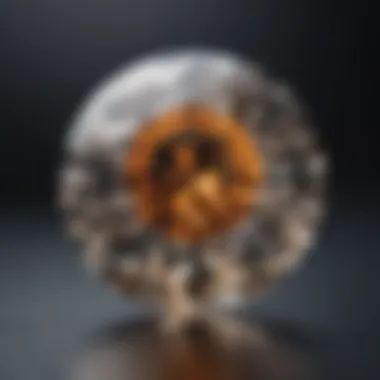
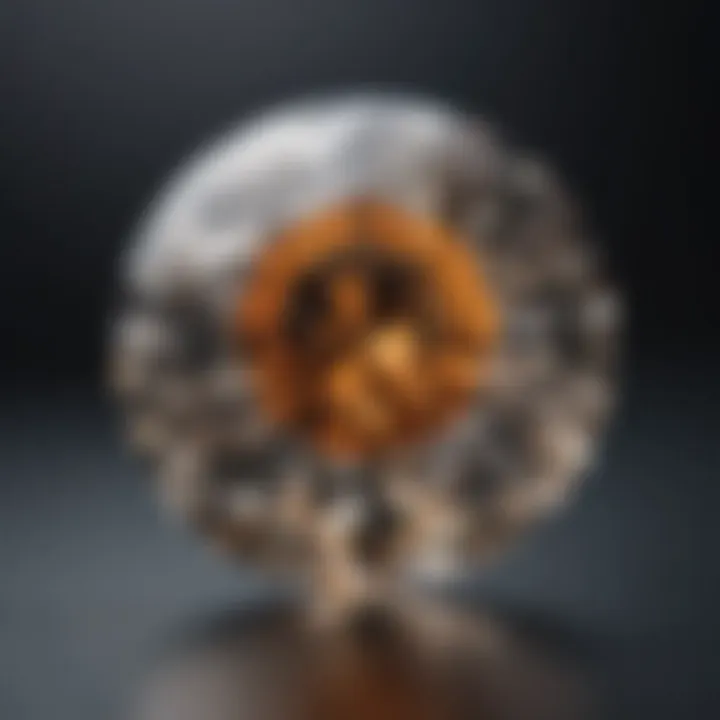
To sum it up, table size in round diamonds is more than just a figure; it’s a vital aspect that affects beauty, perception, and value. Understanding its importance allows buyers to make informed decisions that cater to their preferences and expectations.
Defining Ideal Table Size
When discussing round diamonds, understanding the concept of table size is pivotal. It's not just about numbers; it shapes the overall beauty and allure of the diamond. The table, the flat surface on the top of the diamond, plays a defining role in how light interacts with the stone. This section navigates through the critical aspects of table size, highlighting its significance and what makes it a key factor in selecting these sparkling gems.
Industry Standards
Industry standards for table size in round diamonds are established to guide both buyers and sellers in understanding the ideal proportions. Typically, the table size is expressed as a percentage of the diamond's total diameter. For instance, a table size ranging from 53% to 60% is generally accepted as ideal. Going lower or higher can lead to perceived compromises in beauty and brilliance.
But standards don't just exist in a vacuum. They evolve with trends, technology, and consumer preferences. Jewelers often adhere to these benchmarks not only for the sake of tradition but also to meet the demand for consistent quality.
- Ideal Table Percentage: Most experts suggest aiming for a table percentage between 54% and 58% for optimal performance.
- Too Small or Large: A smaller table can make a diamond look deep and narrow, sometimes leading to reduced brightness. On the contrary, a too-large table may result in a loss of sparkle, causing the stone to appear flat.
Such guidelines are essential for ensuring that the diamonds not only meet aesthetic expectations, but also hold their value over time.
Optimal Range for Round Diamonds
Delving into the optimal range for round diamonds, we see that while the typical standards are useful, the best size may adjust according to desired outcomes. The table size can influence both the visual perception and light performance of the diamond.
- Common Percentages: An optimal table size resourcefully captures light — too small brings about darkness, while too large reduces fiery scintillation. The golden sweet spot remains between 54% and 58%. This range is often where beauty meets practicality.
- Personal Preferences: However, personal taste matters significantly. As it is not one-size-fits-all, gem buyers should keep in mind their specific preferences. A collector might prioritize an unusual cut that could have unconventional table sizes, emphasizing personal style over traditional benchmarks.
In light of these considerations, evaluating the table size against one's tastes is crucial. Knowing the ideal range does not just make for an informed consumer; it also enhances the overall experience of selecting the perfect round diamond. A well-chosen diamond can capture the heart, reflecting vibrant brilliance that shines in any light.
"In diamond buying, knowledge is as sparkling as the gemstones themselves."
The Cut: A Fundamental Component
When it comes to round diamonds, the cut is more than just a stylistic choice. It's a fundamental component affecting every aspect of a diamond's appearance, performance, and overall value. Not only does it define the stone’s shape and style, but it also plays a critical role in the diamond's brilliance and scintillation. Understanding how the cut influences table size helps buyers make informed choices, ensuring they choose a diamond that meets their aesthetic preferences while also maximizing brilliance.
Understanding Diamond Cut
In the world of gemstones, the term "cut" refers to how a diamond has been shaped and faceted. It encompasses various elements like proportions, symmetry, and polish. Each facet of the diamond interacts with light differently, producing the sparkle that draws people in.
The significance of the cut is further highlighted by the well-known grading system, which assesses cut quality in terms of brilliance, fire, and scintillation. For instance, a well-cut diamond will reflect light efficiently and create a dazzling effect, while a poorly cut one may appear dull. The quality of the cut can even overshadow the diamond's carat size or color, emphasizing that in the realm of gemstones, cut often trumps all.
The grading of diamond cut can generally be classified into the following categories:
- Excellent: Highest level of craftsmanship, reflects light beautifully.
- Very Good: Minor deviations, still offers impressive sparkle.
- Good: Acceptable but may lack in brilliance compared to higher grades.
- Fair or Poor: Significant issues with light performance.
To further illustrate this, consider two diamonds of identical carat weight, one with an Excellent cut and the other with a Fair cut. The well-cut diamond is likely to exhibit vibrant brilliance and fire, making it a more desirable choice.
How Cut Affects Table Size
Table size plays a vital role in the diamond's overall cut and performance. The table itself is the flat surface on the top of the diamond, and its size can significantly influence how light enters and exits the gemstone. A well-proportioned table size can maximize a diamond's potential for brilliance. However, there's a balancing act at play.
- A larger table can enhance light entry, potentially leading to increased sparkle. Yet it can also reduce the depth of the stone, affecting light reflection.
- Conversely, a smaller table may contribute to greater depth, allowing for better light return, but it might also create a less dominant appearance.
The optimal table size generally falls within a range that balances both of these factors. A table size of about 53% to 62% of the diamond's diameter is widely accepted as ideal. Why? Because this range allows for a harmonious balance between the brilliance generated by light entering the diamond, and the depth needed for light to reflect back out again.
Ultimately, the ideal table size depends on the cut of the diamond. Factors such as crown angle and pavilion depth also come into play, impacting how effectively a diamond showcases its sparkle. While round diamonds are celebrated for their timeless beauty, understanding the cut's intricacies, including how it shapes table size, is essential for anyone looking to invest in a quality gem.
Important Note: Choosing a diamond with an ideal table size is as much an art as it is a science, necessitating a keen eye and understanding of the geometric principles that underpin a diamond's allure.
Evaluating Table Sizes Across Different Diamonds
Understanding the dynamics of table size in various diamonds provides a clearer picture of their unique characteristics. While many buyers may focus solely on carat weight or cut quality, realizing how table size interacts with those elements is crucial. Evaluating table sizes isn't just an academic exercise; it’s fundamental for making educated purchasing decisions and appreciating the intricacies of diamond design.
The proper evaluation brings to light intricate relationships between size expectations, light performance, and the overall visual appeal of diamonds. Individual preferences may lean towards larger or smaller tables, but understanding the balance between table size and other features creates a more well-rounded perspective about what one is actually buying.
Comparative Analysis
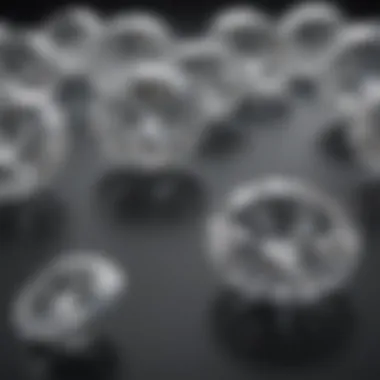

Let’s take a closer look at how table sizes compare across different diamonds, shedding light on their specific implications. The concept of comparing sizes hinges not merely on dimensions but also how these sizes affect aesthetics and performance. Here are a few focal points:
- Proportions Matter: The relation between the table size and the overall diamond dimensions is key. A diamond with a small table may appear deeper, thus changing the way light interacts with its facets. Conversely, larger tables can often create a flatter silhouette.
- Aesthetic Preferences: Individual consumers have varied tastes. For instance, someone looking to showcase a bold piece may prefer a larger table size, believing it adds drama, while others might find more beauty in a smaller, daintier table that emphasizes brilliance.
- Cut Classifications: Different cut classifications, such as Brilliant, Princess, or Oval, exhibit varying table size norms. What one cut defines as 'ideal' in terms of functionality might not apply to another, leading to noticeable differences in performance and aesthetic trait.
Ultimately, comparative analysis reveals that an informed choice in table size can significantly enhance the diamond buying experience, ensuring the selected stone aligns with personal preferences and style.
Real World Examples
To dive deeper, practical examples illustrate how table size can alter perceptions and experiences. Consider the following scenarios:
- Example 1: Engagement Rings: A round diamond engagement ring featuring a larger table size might be quite striking, drawing immediate attention. However, purchasers often overlook that a stone like that might compromise light performance, resulting in less scintillation compared to a moderately sized table that balances proportions.
- Example 2: Fashion Jewelry: In comare, a larger table might work well for fashion rings where the focus is purely on aesthetics rather than performance. For instance, a cocktail ring with a larger table can serve to create a show-stopping statement but may not produce the same quality of light return for someone who prioritizes brilliance.
- Example 3: Custom Made Pieces: Jewelers often customize settings based on the client’s values. A buyer who believes in the importance of brilliance might be better served by a diamond with a smaller table in contrast to a flamboyant setting that requires a larger size for aesthetic reasons.
Understanding through these examples helps clarify that evaluating table sizes across different diamonds is not a one-size-fits-all approach. Each preference and diamond type brings its unique set of circumstances that must be considered.
The Trade-off Between Size and Brilliance
When it comes to round diamonds, finding the sweet spot between table size and brilliance can feel like walking a tightrope. The table size impacts how light interacts with the gem, which in turn influences its brilliance and overall appeal. This section will dissect the balance between these two essential facets, providing a nuanced look that goes beyond mere numbers.
Balancing Table Size and Depth
The relationship between table size and the diamond's depth is akin to a delicate dance. A larger table can amplify the surface area through which light enters. However, if the depth is not proportionate, light may escape rather than reflecting within the stone, leading to less sparkle. It’s like a well-cooked cake: too much or too little of any ingredient can ruin the balance.
In practical terms, a round diamond with a table size of around 53% to 58% typically strikes an excellent balance with depth. If the table size trends too large, say beyond 60%, eyes may start to notice a dull appearance instead of the radiant sparkle that many buyers seek. Here are essential points to ponder:
- Optimum Balance: A good relationship between table size and depth keeps light in play.
- Visual Impact: Diamonds that shine and shimmer command attention in any setting.
- Industry Standards: Familiarizing oneself with common ratios might help enthusiasts choose better.
"Understanding how size correlates with depth is fundamental for achieving desired brilliance."
Effects on Perceived Size
Another layer to the conversation about table size is its impact on perceived size. Larger tables can create an illusion of grandiosity, making a smaller stone look bigger than its actual carat weight. However, there is a catch: an excessive table can diminish optical brilliance. Imagine looking at a painting from a distance; at first glance, it might seem larger, but upon closer inspection, details often reveal a different story.
This phenomenon boils down to the light’s behavior. A diamond with an ideal table size can reflect and refract light effectively, enhancing its visual size and luster. Conversely, a table that’s too large might make the diamond feel flat – losing the depth that captivates. Here are some key points worth mentioning:
- Illusion of Size: A larger table can trick the eye into believing the diamond is bigger.
- Brilliance Compromise: Bigger tables may sacrifice some light performance for perceived size.
- Carat Weight Impact: The right table size can enhance the visual weight without increasing the actual carat.
Finding that fine line between a brilliant display and visual enlargement is crucial for any diamond buyer. Ultimately, understanding the trade-offs involved in table size allows for more informed choices, leading to a gem that’s not just a showpiece but a truly mesmerizing work of art.
Consumer Considerations
When it comes to selecting the perfect round diamond, understanding consumer considerations is not just important—it's essential. The choices made by buyers will not only impact their personal satisfaction but can also significantly influence the overall value of their investment. An informed consumer is able to navigate the nuanced requirements of table size, which in turn affects aesthetics, light performance, and ultimately, a diamond’s sparkle.
What Buyers Should Look For
Selecting a diamond involves much more than just picking the shiniest one in the store. Here are some critical factors buyers should keep in mind:
- Table Size: Look for diamonds with a table size that corresponds to industry standards, typically between 53% to 62%. This range helps maintain the diamond's brilliance and fire.
- Cut Quality: The table size often interacts with the cut of the diamond, influencing how the diamond captures and reflects light. A well-cut diamond will appear more radiant regardless of its size.
- Personal Preference: Consider your style. A larger table may appeal to some, adding to the diamond’s overall mass, while others might prefer a smaller size for its enhancement of brilliance.
- Certification: Always check if the diamond has been graded by reputable organizations like the Gemological Institute of America. Certification provides insight into the quality and specifications, including table size.
Buyers should not overlook the interplay between these characteristics. For instance, a diamond with an ideal table size and an excellent cut will hold more value compared to one with a mediocre cut, even if the latter has a larger size.
Common Misconceptions
Many misconceptions surround diamond purchasing and, particularly, table sizes. Some of these misunderstandings can lead to poor purchasing decisions:
- Bigger Equals Better: A common belief is that a larger table size automatically means better aesthetic value. In reality, too large a table can detract from a diamond’s brilliance and fire.
- Higher Price, Higher Quality: While price can often reflect quality, a higher price does not guarantee an ideal table size. Always evaluate the specific characteristics beyond just the cost.
- All Round Diamonds are the Same: Not all round diamonds are created equal. Variations in table size and cut can lead to vastly different appearances and performance.
- Table Size is Static: The assumption that once a diamond’s table size is determined, it stays the same can mislead buyers. Re-cutting is a viable option to improve brilliance if a diamond has an unfavorable table size, at the cost of some weight.
Understanding these misconceptions can make a world of difference when making a selection. A clear grasp of table sizes empowers buyers, giving them the confidence to make informed decisions that align with both their aesthetic taste and investment goals.
"The beauty of a diamond lies in its cut; a well-rounded understanding of table sizes enhances that beauty."
Being aware of consumer considerations can profoundly influence the purchasing experience, turning a potentially daunting decision into a satisfying yet informed choice. By focusing on specific elements and disregarding common myths, gemstone enthusiasts and collectors can cherish their selections for years to come.
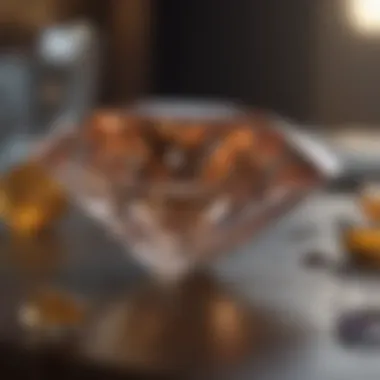
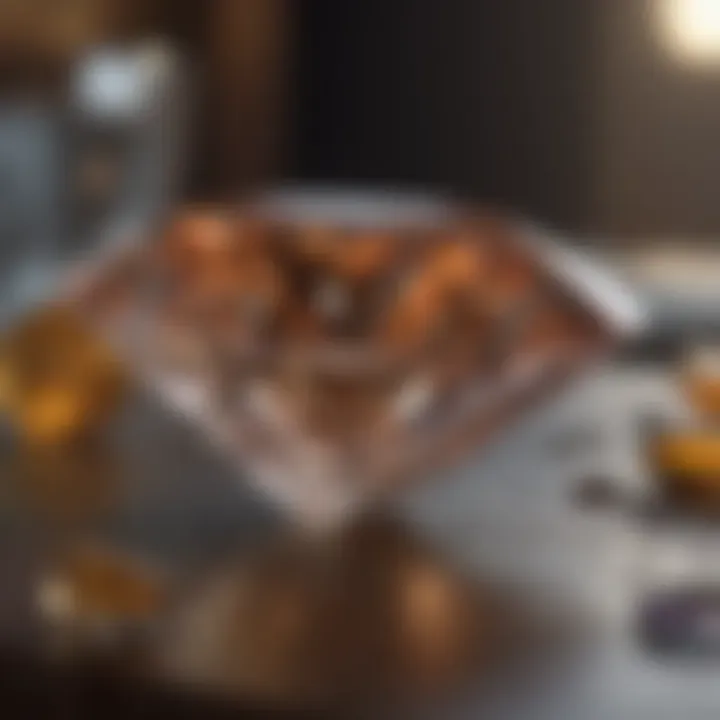
Maintenance and Care
Taking care of a diamond is like tending to a fine wine; it requires understanding and attention to detail. When it comes to round diamonds, the consideration of table size plays a pivotal role in how one maintains and looks after their gem. The table size can influence not only the visual appeal but how susceptible the diamond can be to scratches, dirt accumulation, and overall wear. Jewelry enthusiasts and collectors should understand these nuances to keep their diamonds sparkling for generations.
How Table Size Affects Care Requirements
The size of the table can directly affect maintenance needs. A larger table may seem appealing, but it can be more prone to showing scratches and dirt. This is because a bigger surface area allows for more opportunity for particles to settle and damage the clarity of the stone. In contrast, a smaller table, while it may not exhibit as much brilliance, often requires less frequent cleaning.
- Cleaning Frequency: Larger table diamonds might need more regular cleaning. Regular exposure to lotions, perfumes, or even just daily wear can accumulate grime.
- Scratching Risk: With a bigger area exposed, there's a higher chance of unintentional chips or scratches from hard surfaces.
- Visual Clarity: Dust and smudges are more noticeable on larger table diamonds, which may require proactive care to maintain their appearance.
Best Practices for All Table Sizes
Ensuring the longevity of any round diamond involves adopting specific care techniques, especially in relation to its table size. Here are some useful tips that cater to both large and small table diamonds:
- Use a Soft Cloth: Always wipe your diamond with a soft, lint-free cloth after wearing it to remove oils or dust.
- Gentle Cleaning Solutions: When deep cleaning, opt for mild soapy water. Avoid harsh chemicals as they can scratch the diamond or damage the setting.
- Regular Inspections: Check settings regularly to ensure that the diamond is securely placed, as a loose setting can lead to accidental loss, particularly in larger diamonds that might get caught or snagged.
- Limit Exposure: Minimize contact with chemicals in cleaning products, swimming pools, or hot tubs. This will help avoid wear on both the diamond and its setting.
- Seek Professional Help: Have a professional jeweler conduct a thorough clean and inspection at least once a year, or more frequently if the diamond is worn often.
"Much like a finely crafted piece of art, round diamonds deserve the utmost care to maintain their brilliance and allure."
The Role of Glitter and Fire
The interplay of glitter and fire plays a significant role in the beauty and allure of round diamonds. It is not just about aesthetic appeal; these elements contribute to the overall perception of quality, brilliance, and the emotional experience that comes with owning or beholding a finely cut diamond. Understanding how glitter and fire manifest in these stones can transform how we view diamonds, particularly in relation to their table size.
Defining Glitter and Fire
To put it simply, glitter and fire are two fascinating aspects of a diamond's sparkle.
- Glitter refers to the flashes of light a diamond emits as it moves. It's akin to the twinkling of stars on a clear night, capturing light in a way that's subtle yet captivating.
- Fire describes the colorful flashes that occur when light disperses through the diamond. It's the interplay of light and color that adds an extra layer of appeal, much like a rainbow after a summer rain.
When talking about round diamonds, the table size can showcase or diminish both glitter and fire. A larger table may allow for more light entry, enhancing the glitter effect, while limiting the angles at which light can bend, potentially lessening the fire. Conversely, a smaller table could amplify color dispersion but might not catch as much light for glitter.
How Table Size Influences Spectacle
The table size is the flat surface on the top of a diamond, and its dimensions significantly impact how light refracts and reflects within the stone.
- Larger Tables:
- Smaller Tables:
- They allow more light to enter the diamond.
- This can create vibrant glittering effects, making the diamond appear to dazzle from various angles.
- While they may not capture as much overall light, the light that does enter can be refracted into striking colors.
- This is where fire comes into play, providing that captivating burst of color.
Finding the balance between table size and the resulting brilliance is vital. Consumers should be aware that personal preference also comes into effect. Some might prefer more glitter, while others opt for a fiery display of color.
Ultimately, understanding how table size interacts with these elements helps collectors and jewelry designers make informed decisions that resonate with their aesthetic desires.
"A diamond's allure isn't merely about its clarity or carat; it's the whisper of light dancing within, a tale told through glitter and fire."
By comprehending the intricacies of glitter and fire, you can better appreciate how table size plays a role in the overall spectacle of a diamond, enriching your gemstone experience.
Ending: The Final Verdict on Table Size
When it comes to round diamonds, table size weaves a complex narrative that affects not just aesthetic allure but also performance and value. After peeling back the layers, we see that choosing the right table size is a balancing act, one where personal preference collides with scientific principles. The significance of this choice cannot be overstated as it holds implications for both enjoyment and investment.
Summarizing Key Insights
Throughout this exploration, several core points emerge:
- Impact on Brilliance: The table size directly influences how light interacts with the diamond. A well-proportioned table can enhance brilliance, making a diamond appear more alive and vibrant.
- Balance of Proportions: Ideal table sizes often align with table depth to create a harmonious visual effect. For example, a table that’s too big may lead to a flat appearance, while a tiny table can diminish the diamond’s ability to reflect light.
- Trade-offs in Size Preferences: Buyers often grapple between the desire for larger stones and the need for optimal performance. Understanding this trade-off is crucial.
- Personal and Market Preferences: Ultimately, choice plays a huge role. Different buyers have varying tastes influenced by current market trends and personal experiences.
The discussions we’ve had underscore that knowing the ideal table size is more than just a technical decision; it’s a journey into understanding what makes a diamond truly shine.
Final Thoughts for Enthusiasts
For gemstone enthusiasts and collectors, the pursuit of the perfect round diamond requires more than just an eye for beauty; it demands knowledge. The intricate relationship between table size and key factors like brilliance and cut should inform every upcoming acquisition.
Remember, just because something sparkles doesn’t mean it’s the best choice for you. Here are a few points to ponder before making a purchase:
- Stay Informed: Keep abreast of the latest insights in diamond cut and table size. Websites like Wikipedia and Britannica offer great overviews and deep dives into these subjects.
- Visualize and Compare: Seeing diamonds in person can make a world of difference in your understanding. If possible, compare different options side by side.
- Trust Your Instincts: While numbers and specs are important, personal preference matters. Choose what resonates with you, as this is a piece that you may cherish for years.



